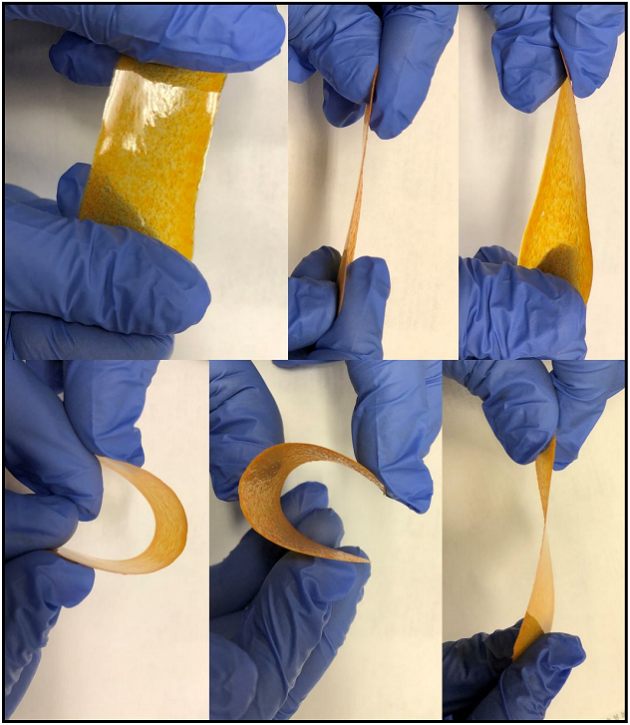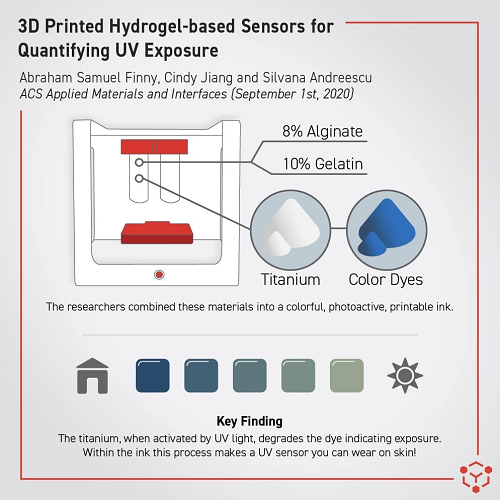Wearable 3D Printed Sensors Could Keep You Safe from Sunburn
As a very pale person, the struggle against sunburn is real, and as Clarkson University researchers explain, about 1.7 million new skin cancer cases are diagnosed in the US each year that result from the sun’s ultraviolet (UV) radiation. However, that doesn’t mean we need to hide in the dark during the summer, because most UV radiation exposure is only intermittent. But we still need to take precautions against getting a sunburn, which normally means frequently applying copious amounts of sunscreen. But this research team may have a better solution, and it involves 3D printed wearable technology, which has been used in the past for healthcare monitoring applications.
Silvana Andreescu, Professor and Egon Matijevic Endowed Chair of Chemistry and Biomolecular Science at Clarkson, and two members of her lab, graduate student Abraham Finny and undergraduate student Cindy Jiang, published a paper about their work developing 3D printed, hydrogel-based, non-toxic sensors that can prevent sunburns by indicating unexpected exposure to damaging rays of UV light.
The abstract states, “Exposure to excessive ultraviolet (UV) radiation can have detrimental effects on human health. Inexpensive easy-to-use sensors for monitoring UV radiation can allow broad-scale assessment of UV exposure, but their implementation requires technology that enables rapid and affordable manufacturing of these sensors on a large scale. Herein, we report a novel three-dimensional (3D) printing procedure and printable ink composition that produce robust, flexible, and wearable UV sensors.”
The researchers, who are also affiliated with 3D bioprinting company Allevi, thought it would be great to have a small, inexpensive way to offer UV light detection, and developed a custom bioink that can be 3D printed into a UV sensor that’s biocompatible, so it’s safe to wear on the skin, as well as biodegradable.
Andreescu explained, “We decided to explore the capabilities of 3D bioprinting to manufacture these wearable UV-responsive sensors, as 3D printers have become inexpensive and accessible.”
They used 3D bioprinting to make the functional, mechanically stable, wearable sensors, which allowed for one-step, reproducible fabrication. To form a composite ink, the team combined 10% gelatin and 8% alginate, but the main photoactive component was common titanium oxide powder, which releases electrons and changes color when exposed to UV radiation…similar to a color-changing tattoo.
“To fabricate the sensors, a color-changing hydrogel ink was first developed from which standalone constructs were 3D printed. The ink contains alginate, gelatin, photoactive titanium dioxide nanoparticles, and dyes (methyl orange, methylene blue, and malachite green) in which the nanoparticles are used to initiate photocatalytic degradation of dyes, leading to discoloration of the dye,” the team wrote.
“The viscosity and ink composition were optimized to achieve printability and tune the mechanical properties (e.g., modulus, hardness) of the sensors.”

Schematic illustrating the proof of concept integration of bioprinting with conventional 3D printing. A 3D printable model (A) as a holder for the sensor was designed and printed as a blue bracelet (B) using blue PLA filament in an Ultimaker 3 printer. The model was further tweaked to accommodate the sensor at the center by providing space for sensor integration and printed using pink PLA filament. A single sensor model (C) was then 3D bioprinted on top of the 3D printed bracelet to get the final bracelet with the sensor integrated at the center (E). The bracelet with the sensor was then exposed to UV to test for performance, and the degradation curve (F) was obtained. The sensor remained anchored to the 3D printed bracelet throughout the UV exposure testing and maintained excellent stability.
The researchers used multiple colored dyes, such as malachite green and methyl orange, during testing, and said that their bioink has “excellent 3D printing properties,” as it exhibits shear-thinning behavior when it’s enclosing titanium oxide and dye particles, so it can extrude well and hold a patch shape after it’s printed. The gelatin forms a partial chemical crosslink with the alginate when it’s cold, and the alginate remains “partially cross-linkable by cations,” which makes the ink more adaptable.

To demonstrate the excellent mechanical properties of the dried sensors, a 75 x 25 x 0.5mm thin film was 3D printed and dried. This band was then exposed to various mechanical forces to see how it responded. After being bent at a 90˚ angle on each side for 50 times and twisted on each side for 50 times, the band did not deform. Tensile testing of these bands was done before and after these tests. Even when a uniaxial force of 100 N was applied along the length of the band, the band did not break or deform uniaxially.
Additionally, the team reports that the color changes in the 3D printed constructs were predictable. When the titanium oxide was excited, a chain of reduction-oxidation reactions within the hydrogel would start, which eventually degraded the contained organic molecules. Because the hydrogel held enough dye, titanium oxide, and water, these changes were visible, and allowed for enough UV penetration to complete the reaction “in a timely manner.” When the researchers tested their 3D printed wearable sensor outdoors, they observed a decrease in color intensity that matched the length of exposure.

A 10 x 10 mm square sensor was 3D printed on top of a transparent pressure-sensitive packing tape (A, D) and outdoor testing (B) was performed for one hour after the sensor was stuck to the back of a subject’s hand. The subject then took a walk around the university campus to mimic real life use. At the end of one hour, a colorimetric change was clearly observed (C, E). It should be noted that the sensor was not consistently exposed to the sun for the entire hour as the subject walked through areas where there was only random exposure to UV radiation.
Another potential application for these inexpensive 3D printed sensors could be in the UV sanitation field. Here, a sensor could determine whether or not a tool or piece of clothing has been exposed to enough UV light that it’s considered sanitized.
(Source: Allevi)
Subscribe to Our Email Newsletter
Stay up-to-date on all the latest news from the 3D printing industry and receive information and offers from third party vendors.
Print Services
You May Also Like
3D Printing Grows to $15.9B in 2024 Amid Shifting Industry Dynamics
The global additive manufacturing (AM) market reached $15.9 billion in calendar year 2024, according to “Q4 2024 3DP/AM Market Data and Forecast” from Additive Manufacturing Research (AM Research). Despite a...
Low-cost “Suzy” Polymer Powder 3D Printer is Faster and Cheaper than Past Models
Polish laser powder bed fusion (LPBF) firm Sinterit has released a follow-up to its predecessors, Lisa and Nils, called Suzy, a $19,490 printer equipped with a 30W fiber diode laser....
BellaSeno’s 3D Printed Breast Implants Keep Shape with 87% Fat Volume, Avoids Silicone Risks
At a medical conference in Austin this week, a new kind of breast implant took center stage. It is not made from silicone but from a 3D printed, fully resorbable...
Australia’s Untapped Potential as a Disruptive Innovator: SPEE3D CTO Steven Camilleri Explains Why He Wants to Make Stuff There
When I first met Steven Camilleri in 2023, the CTO of additive manufacturing (AM) OEM SPEE3D shared a quote with me from Clayton Christensen, the late Harvard professor who popularized...




























